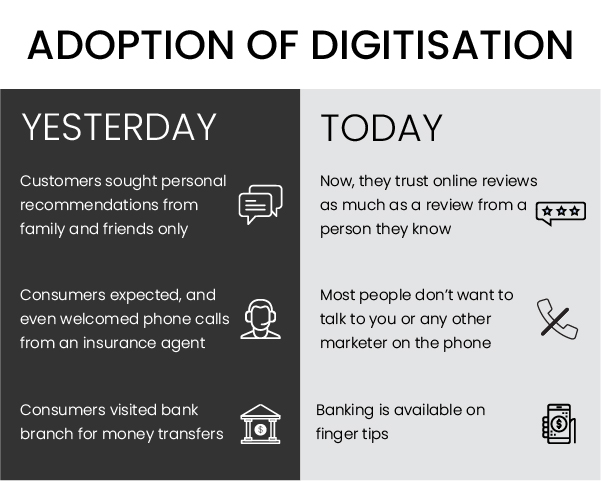How SMEs can succeed in a digital world
Learning & Development
305 week ago — 10 min read
Digitisation offers small businesses with unprecedented opportunities to tap new markets, improve their offerings and better serve their customers. The undeniable question is, ‘How can SMEs succeed in a digital world?’
The 3 key elements of this question are
- SMEs
- Success
- The digital world
SMEs as the term describes are small and medium enterprises. But to me SME are all about ‘large’ dreams, commitment, agility, a never say die attitude, and a lot of passion. Now what does success mean? While it may mean different things to different people, it is safe to define it minimally as growing faster than your industry or even faster than anybody else in your industry; and a second element is future proofing this growth by anticipating changes in your business and industry and constantly evolving your business model.
This brings us finally to the digital world. You can feel the widespread adoption of digital tools like smartphones and tablets around you. The internet has penetrated every aspect of our lives. From a business owner or leader’s perspective, we can certainly feel that but as consumers as well, our experiences have transformed.
Do you remember the last time you stood in line at the box office to buy a movie ticket? Most likely not. Let us look at this simple infographic to understand better:

We perform most of these services online, and are not shy of changing service providers, for example, to change our bank if our bank doesn’t provide us some of these conveniences.
Now if you flip this coin, on the other side we are the business and are providing our customers and clients services and they too may have certain expectations from us. It is ideal to prepare ourselves earlier than at a time when there is no choice.
To use today’s technology you don’t need to be a technocrat. To go to an unknown destination we use the map feature on our phones. If we can imagine a dream solution in our business, we will definitely be able to find a digital way of delivering better to our customers.
This brings us to the question we all are looking an answer for. What is the success mantra for businesses to grow and succeed in a digital world? Before I explain further, I want you to ask yourself the following questions:
Are you wondering how to connect with your consumers from a transactional to a value addition point of view?
Are you wondering how your organisation can keep pace with the digital world and thrive?
Are you wondering how you can leverage technology to optimise functions from sales to marketing?
If yes, then I would like you to consider three things while thinking of success for your business and its growth in today’s world:
1. Customer view
Become your own client: Think of your business as your customers and clients think of it. See their pain points and how you may be able to assist them do more business with you.
2. Execution and approach
Move quickly: Timing is key. Technology has eliminated entry barriers for new entrants to disrupt industries that are relatively new for these players. This makes it critical for established or even new businesses to move quickly, and we will cover how to achieve this.
3. Embrace technology
To use today’s technology you don’t need to be a technocrat. To go to an unknown destination we use the map feature on our phones. If we can imagine a dream solution in our business, we will definitely be able to find a digital way of delivering better to our customers.

Let’s delve deeper into each of these points.
Customer View
Digital advancements have empowered customers more than ever before and this has made them more demanding. Hence it is critical for every business to not only understand customer expectations and meet them, but also connect with customers and become a part of their life.
If you listen carefully, this is what your customers are saying:
- Understand my needs
- Become a part of my life – don’t sell me products or services. Instead tell me on how you can help solve my problems, perform tasks or increase efficiencies
- Be where I expect you to be
- Respond to me quickly – customers now are used to instant access to information. From a time where bank balances were checked via monthly statements, customers now want to know status of fund transfers, bank balances immediately.
But how can you achieve this?
1. Ask your audience for insights
The true value of social media is felt only when you open up the floor for conversation with your customers and try understanding their point of view. Create polls, reply to questions, and ask for feedback about your products and services.
.
2. Be curious
Get genuinely interested in your customers and cultivate an ‘investigative mentality.’ Seek out your customers online and find out who they follow besides your company. Learn what their interests are, what they do in their spare time, what they believe, and how they engage with friends. Do you notice any patterns? Sometimes, good old fashioned curiosity can often fill in the gaps.
3. Collaborate with your users
Customer collaboration is one of the most powerful ways to ensure that your product excites your users. Your customers will gladly tell you what they want and if you’re smart, you’ll listen to them.
4. Delight your customers
The number one reason customers or clients switch brands or companies have nothing to do with the quality of the product/service or the price. The reason people leave companies is that they feel like they are not valued. The good news is it doesn’t take much to delight your customers. Providing good customer service or ensuring that they have effective means of communicating with you often mitigates problems before they begin.
Execution and Approach
Digitisation has lowered entry barriers, causing long-established boundaries between sectors to tumble. Competitors are emerging form unexpected places. Web-based service providers in telecommunications or insurance, for example, can now tap markets without having to build distribution networks of offices and local agents. Effectively mining data on risks, incomes and preferences of customers can open a world of opportunities for them.
Rakuten, the Amazon of Japan, is using its network to offer financial services. Powerhouses like Google and Twitter are testing waters way beyond their current business model by venturing into Google Wallet and Twitter’s retail offering.
On the other hand, Kodak filed for bankruptcy in 2012 after being the synonymous with photography. It did pivot its business model, but certainly not in the way it had for over 13 decades. Yet, organisations faced with similar circumstances have been able to make the transition and even thrive. They have embraced the only constant – change. And have done so rather swiftly and quickly and in an ‘agile’ manner.
What is agile? You may ask or isn’t agile for software developers? The answer is, not any more.
The key principles of an agile approach are:
- Shorter durations - Break down large deliverable in to smaller ‘sprints’ that is a set period of time during which specific tasks must be completed.
- People centric -Focus on your customers and clients. Deliver as per your customer expectations and not based on what your business may have inherited.
- Creating Value
- Regular and quick intervals -The agile mindset is well suited for the digital world, as both consumers and technology is moving quick, and so should you. Learn from smaller projects, and take those learnings to extrapolate.
Embrace Technology
As consumers, we are using technology for increased convenience more than ever. Paying for coffee at Starbucks through a smart phone app or checking in via a tablet kiosk at a hotel are interactions that have simplified chores, saving us time and effort.
Beauty of digital solutions is that the complexity is behind the curtains for the consumer. For you as a business, there are several added advantages of leveraging technology:
- Cost savings - Investing in digital technologies can, on the face of it, appear expensive, but in many cases, it can be a highly cost-effective decision. Digital technology can help to streamline processes, increase efficiency, improve productivity and save businesses money. A short-term investment for long-term financial stability makes business sense.
- Improved efficiency and increased productivity - To achieve business success, efficiency and productivity are vital. Digital technology can help improve communication, collaboration, content management, access to analytics data and social networking as well as staff and customer experience.
- Maintain a competitive advantage - If your company fails to embrace digital technology, then it will fall behind competitors who do choose to embrace it. This can lead to decreased sales, a reduction in profit and a downwards trend that can be difficult to revert.
Even for you as business owners, there are several digital technology tools and web solutions in the market that can help increase efficiency, reduce time to market, and find more customers and suppliers. GlobalLinker is also one such solution you should embrace to find more customers or suppliers.
Click here to check out the complete webinar presented by me.
Network with SMEs mentioned in this article
View Summi 's profile
Most read this week
Trending
Ecommerce 6 days ago

















Comments (3)
Share this content
Please login or Register to join the discussion